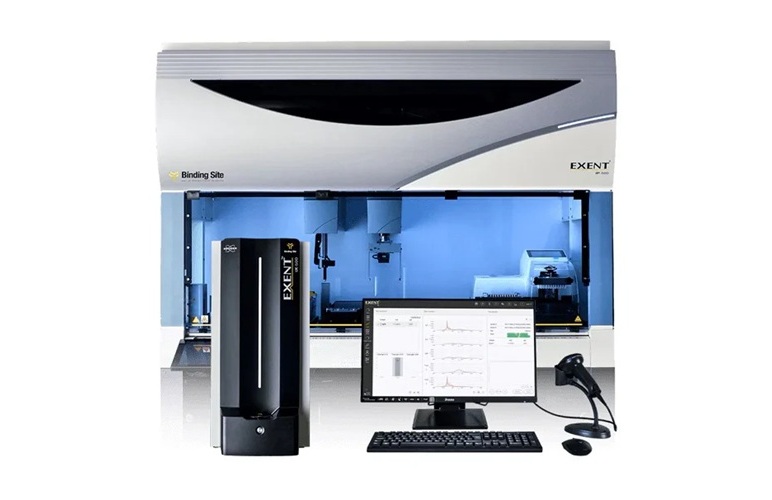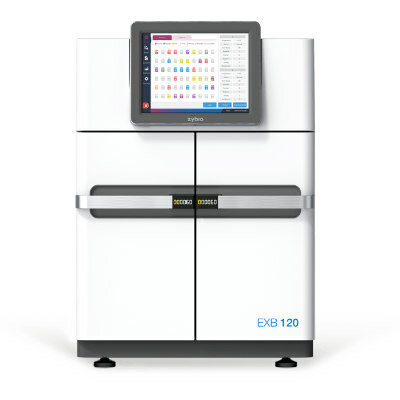Molecular Diagnostics Dominated by Five Companies
|
By LabMedica International staff writers Posted on 17 Feb 2014 |
The latest analysis from Kalorama Information (New York City, NY, USA) finds that 5 companies currently dominate the molecular diagnostics market.
According to report, the 5 companies that currently own the majority of the molecular diagnostics (MD) market are Roche, Hologic, Qiagen, Becton Dickinson, and Abbott, and these alone were estimated to have earned 60% of revenues in the 5.5 billion MD market in 2013.
Top-tier companies are said to continue to dominate due to their global reach and multisegment participation. As in vitro diagnostics (IVD) in North America and Europe offer little growth opportunities for the vast number of tests, the top tier has invested in molecular and personalized medicine testing and has reinforced international connections. The report adds that while the names of the dominating players have not changed extensively in recent years, their revenue growth rates have. High growth has shifted to innovators, while leaders are seeing flatter revenues. For example, “Roche holds the number one market position but growth is slowing,” said Shara Rosen, author of the report. “Roche Diagnostics once earned close to double-digit revenue growth in its molecular test business. This has slowed in the last 2 years.”
The report said that IVD veterans Becton Dickinson, Gen-Probe (now part of Hologic), Abbott Diagnostics, and Siemens Healthcare hold their own in a highly competitive environment, while newcomers Meridian Biosciences and GenMark have made gains with user-friendly, infectious disease tests. Meanwhile, Novartis has stepped out of blood screening to concentrate on other business units.
According to the report, IVD tests are being developed constantly and MD is becoming a go-to resource in clinical practice and is currently the faster-growing part of the diagnostics market.
These and additional findings are published in Kalorama’s "Molecular Diagnostics Six Month Update," the latest, extensive market analysis of the IVD segment, with a bias towards the more developed areas (North America and Western Europe). Given the amount of activity in test development and regulatory and reimbursement challenges, Kalorama focused this update on the last half of 2013.
Related Links:
Kalorama Information
Molecular Diagnostics Six Month Update
According to report, the 5 companies that currently own the majority of the molecular diagnostics (MD) market are Roche, Hologic, Qiagen, Becton Dickinson, and Abbott, and these alone were estimated to have earned 60% of revenues in the 5.5 billion MD market in 2013.
Top-tier companies are said to continue to dominate due to their global reach and multisegment participation. As in vitro diagnostics (IVD) in North America and Europe offer little growth opportunities for the vast number of tests, the top tier has invested in molecular and personalized medicine testing and has reinforced international connections. The report adds that while the names of the dominating players have not changed extensively in recent years, their revenue growth rates have. High growth has shifted to innovators, while leaders are seeing flatter revenues. For example, “Roche holds the number one market position but growth is slowing,” said Shara Rosen, author of the report. “Roche Diagnostics once earned close to double-digit revenue growth in its molecular test business. This has slowed in the last 2 years.”
The report said that IVD veterans Becton Dickinson, Gen-Probe (now part of Hologic), Abbott Diagnostics, and Siemens Healthcare hold their own in a highly competitive environment, while newcomers Meridian Biosciences and GenMark have made gains with user-friendly, infectious disease tests. Meanwhile, Novartis has stepped out of blood screening to concentrate on other business units.
According to the report, IVD tests are being developed constantly and MD is becoming a go-to resource in clinical practice and is currently the faster-growing part of the diagnostics market.
These and additional findings are published in Kalorama’s "Molecular Diagnostics Six Month Update," the latest, extensive market analysis of the IVD segment, with a bias towards the more developed areas (North America and Western Europe). Given the amount of activity in test development and regulatory and reimbursement challenges, Kalorama focused this update on the last half of 2013.
Related Links:
Kalorama Information
Molecular Diagnostics Six Month Update
Latest Industry News
- Abbott Acquires Cancer-Screening Company Exact Sciences
- Roche and Freenome Collaborate to Develop Cancer Screening Tests
- Co-Diagnostics Forms New Business Unit to Develop AI-Powered Diagnostics
- Qiagen Acquires Single-Cell Omics Firm Parse Biosciences
- Puritan Medical Products Showcasing Innovation at AMP2025 in Boston
- Advanced Instruments Merged Under Nova Biomedical Name
- Bio-Rad and Biodesix Partner to Develop Droplet Digital PCR High Complexity Assays
- Hologic to be Acquired by Blackstone and TPG
- Bio-Techne and Oxford Nanopore to Accelerate Development of Genetics Portfolio
- Terumo BCT and Hemex Health Collaborate to Improve Access to Testing for Hemoglobin Disorders
- Revvity and Sanofi Collaborate on Program to Revolutionize Early Detection of Type 1 Diabetes
- GSI Group Acquires Blood Processing Equipment Manufacturer GenesisBPS
- ELITech and Hitachi High-Tech to Develop Automated PCR Testing System for Infectious Diseases
- Lumiquick Acquires Aoxre to Expand Global IVD and Research Capabilities
- Lunit and Agilent Partner to Develop AI-Powered Cancer Diagnostics
- Qiagen and Oxford Gene Technology Partner on Sequencing Panel Interpretation
Channels
Clinical Chemistry
view channel
Chemical Imaging Probe Could Track and Treat Prostate Cancer
Prostate cancer remains a leading cause of illness and death among men, with many patients eventually developing resistance to standard hormone-blocking therapies. These drugs often lose effectiveness... Read more
Mismatch Between Two Common Kidney Function Tests Indicates Serious Health Problems
Creatinine has long been the standard for measuring kidney filtration, while cystatin C — a protein produced by all human cells — has been recommended as a complementary marker because it is influenced... Read moreMolecular Diagnostics
view channel
Blood Test to Help Low-Risk Gastric Cancer Patients Avoid Unnecessary Surgery
Accurately identifying lymph node metastasis in early-stage gastric cancer remains a major clinical challenge. CT imaging often misses up to half of lymph node–positive cases, leading clinicians to recommend... Read more
First-Of-Its-Kind Automated System Speeds Myeloma Diagnosis
More than 176,000 people are diagnosed with multiple myeloma worldwide each year, yet the current diagnostic pathway can be slow and uncertain, often relying on a highly subjective interpretation of test results.... Read moreHematology
view channel
Platelet Activity Blood Test in Middle Age Could Identify Early Alzheimer’s Risk
Early detection of Alzheimer’s disease remains one of the biggest unmet needs in neurology, particularly because the biological changes underlying the disorder begin decades before memory symptoms appear.... Read more
Microvesicles Measurement Could Detect Vascular Injury in Sickle Cell Disease Patients
Assessing disease severity in sickle cell disease (SCD) remains challenging, especially when trying to predict hemolysis, vascular injury, and risk of complications such as vaso-occlusive crises.... Read more
ADLM’s New Coagulation Testing Guidance to Improve Care for Patients on Blood Thinners
Direct oral anticoagulants (DOACs) are one of the most common types of blood thinners. Patients take them to prevent a host of complications that could arise from blood clotting, including stroke, deep... Read moreImmunology
view channel
Gene Signature Test Predicts Response to Key Breast Cancer Treatment
DK4/6 inhibitors paired with hormone therapy have become a cornerstone treatment for advanced HR+/HER2– breast cancer, slowing tumor growth by blocking key proteins that drive cell division.... Read more
Chip Captures Cancer Cells from Blood to Help Select Right Breast Cancer Treatment
Ductal carcinoma in situ (DCIS) accounts for about a quarter of all breast cancer cases and generally carries a good prognosis. This non-invasive form of the disease may or may not become life-threatening.... Read moreMicrobiology
view channel
Rapid Assay Identifies Bloodstream Infection Pathogens Directly from Patient Samples
Bloodstream infections in sepsis progress quickly and demand rapid, precise diagnosis. Current blood-culture methods often take one to five days to identify the pathogen, leaving clinicians to treat blindly... Read more
Blood-Based Molecular Signatures to Enable Rapid EPTB Diagnosis
Extrapulmonary tuberculosis (EPTB) remains difficult to diagnose and treat because it spreads beyond the lungs and lacks easily accessible biomarkers. Despite TB infecting 10 million people yearly, the... Read more
15-Minute Blood Test Diagnoses Life-Threatening Infections in Children
Distinguishing minor childhood illnesses from potentially life-threatening infections such as sepsis or meningitis remains a major challenge in emergency care. Traditional tests can take hours, leaving... Read more
High-Throughput Enteric Panels Detect Multiple GI Bacterial Infections from Single Stool Swab Sample
Gastrointestinal (GI) infections are among the most common causes of illness worldwide, leading to over 1.7 million deaths annually and placing a heavy burden on healthcare systems. Conventional diagnostic... Read morePathology
view channel
AI Tool Outperforms Doctors in Spotting Blood Cell Abnormalities
Diagnosing blood disorders depends on recognizing subtle abnormalities in cell size, shape, and structure, yet this process is slow, subjective, and requires years of expert training. Even specialists... Read more
AI Tool Rapidly Analyzes Complex Cancer Images for Personalized Treatment
Complex digital biopsy images that typically take an expert pathologist up to 20 minutes to assess can now be analyzed in about one minute using a new artificial intelligence (AI) tool. The technology... Read moreTechnology
view channel
AI Saliva Sensor Enables Early Detection of Head and Neck Cancer
Early detection of head and neck cancer remains difficult because the disease produces few or no symptoms in its earliest stages, and lesions often lie deep within the head or neck, where biopsy or endoscopy... Read more





















